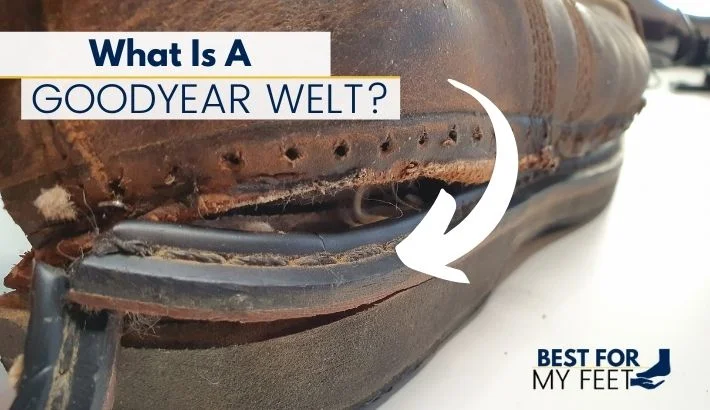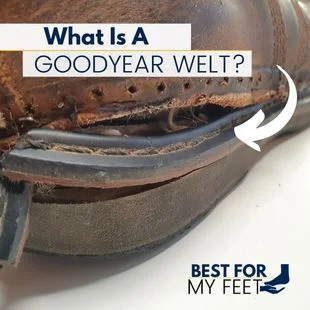I didn’t grow up with the knowledge of all the different ways a shoe could be constructed. It was always just a quick trip to Pay-Less or Walmart to grab a couple pairs of shoes that would last just that school year.
As I’ve gotten older though, I have grown to appreciate shoes and boots that cost more but last a lot longer and make my feet happy.
Maybe you have found yourself wanting to learn more about the way shoes are made or you came across this feature as you were browsing for footwear and now you’re asking yourself:
What does Goodyear welt even mean?

If you’ve been wondering what the heck Goodyear welt means, let me tell you that Goodyear welt is simply a piece of material (leather, plastic, rubber) that’s sewed around the shoe or boot to give it a better and more resistant structure.
Below, I’m going to talk about one of the more popular shoe construction methods (the Goodyear Welt method) and briefly compare it to a few of the others out there too…
…so keep reading, there’s a lot of good info in here!
The Goodyear Welted Footwear
There are several different ways shoes and boots are constructed. One of the more popular ways of shoemaking involves the Goodyear welt.
A Goodyear welted shoe is made with a welt, which is a thin strip of leather (though other materials may be used as well, like rubber or plastic) that runs along the perimeter of the outside of the shoe and is then stitched in between the sole and upper in such a way that it creates a solid seal that repels water.
This method ensures a strong, durable, long-lasting, and water-resistant shoe that can be repaired with ease.
The welt can be easily unstitched, which allows for the sole to be removed from the upper without causing damage to the rest of the shoe.
Quick history of the Goodyear Welt
Many assume Charles Goodyear Jr. was the man behind the invention and creation of the Goodyear welt, but archeologists have been finding evidence of this method being used in shoemaking as far back as the 1600’s.
The Goodyear welt method was done by hand all those years until a man named James Hanan produced a sewing machine equipped with the necessary components to sew welts onto shoes.
The machine did not perform as expected and needed adjustments.
Charles Goodyear Jr
Enter Charles Goodyear Jr. and the fortune that came with being the son of Charles Goodyear of Goodyear Tires. Charles bought the patent for this machine off of Hanan and proceeded to fine-tune the machine with a few inventors at his side.
Finally, in the year 1872, Charles Goodwin Jr. introduced the first working welting machines and changed the landscape of shoemaking. Many shoes could be made in a very short time, and so the cost of a shoe went down.
A few years later in 1875, Charles filed for a patent for the machine that would be named after him and which would result in his name being forever associated with the welting shoe-making method.
Is it a Goodyear welt or not? How can you tell?
It’s a bit tough to know really unless you cut the boots in half and you see what’s inside like we did with this boot (Timberland PRO Pit Boss Cut In Half).
Look at the product description as well, most sellers will say if it’s a Goodyear welt shoe or boot.
If you’re in-store, ask the salesperson. Don’t just buy them because they look like Goodyear welted as many shoemakers mimic the look of a Goodyear Welt when in fact it is just false stitching made by molds.
Different types of Goodyear welt sole construction
There are basically two types at the time I’m writing this article:
- 360° Goodyear welted footwear
- 270° Goodyear welted footwear
360 degrees Goodyear welt

Yes, you’ve guessed it. This is a piece of welt that’s stitched around the footwear.
Most of the time a single stitch is used but there are some rugged work boots that need double stitching in order to hold the beat-up they’re submitted to daily and last longer in extreme conditions.
270 degrees Goodyear welt

The other type of Goodyear welt construction you’ll see in footwear is the 270 degrees Goodyear welt. It’s also known as 3/4 Goodyear welt.
This simply means that the welt is stitched around the boot or shoes with the exception of the heel.
360° VS 270° Goodyear welt: which one is better?
If you’re having doubts about which one you should go for the answer is simple at least in my opinion.
Do you want more chunky looking footwear or do you prefer to look sleeker?
Not having to add the Goodyear welt all around the boot will make the boot or shoe look slimmer if that’s important to you.
Having a 360 degree Goodyear welted boot will make it more waterproof though whereas the 270 degrees construction will leave your heel exposed to moisture and water.
The cobbler will have a bit more work to do when resolling a pair of boots or shoes since the heel needs to be nailed to the upper.
But for you, as a user, it doesn’t really make that much of a difference if the boot is 270 or 360 degrees Goodyear welted (other than what I said above).
So in my opinion it only comes down to aesthetics and your own personal taste.
Is Goodyear welt better than other sole construction techniques?
When deciding on a quality pair of boots or shoes, you will want to know the different kinds of sole constructions that are used in shoemaking and how they compare to one another.
We won’t get into too much comparison here, but we will discuss some key points in the different sole construction techniques and how they measure up to the Goodyear welt.
Blake Stitch vs Goodyear Welt
The Blake stitch makes for a more affordable shoe option. It is a simpler method that shoemakers find easier to repair.
When you wear a pair of shoes with the Blake stitching, you will notice a significantly more flexible sole due to the fewer layers that are stitched together to attach the sole to the upper.
There is no actual strip of leather (welt) like you find in the construction of shoes made with the Goodyear welt. A Goodyear welt involves more shoe material as the stitching is done on the outside to the inside, going through the welt, upper, insole, and sole.
Though this makes for a stiffer shoe, the Goodyear welt offers better water-resistant qualities than the Blake stitch does.
The Blake welt is done on the inside of the shoe which allows for a closer cut sole due to there being no outside stitching.
This means a Blake stitch offers a smoother-looking shoe with less sole. A Goodyear welt is stitched from the outside to the inside, so there is a lip or edge all around the bottom of the shoe that is necessary for this stitch.
Both offer soles that are easily repaired, but they are not equal in looks or functionality. The Goodyear is sure to offer a durable shoe able to handle a variety of weather, but the Blake welt gives you the same ease in repairing as well as a smoother look.
Stitchdown vs Goodyear Welt
If you talk to any boot fanatic, you will probably hear them speak positively about both the stitchdown construction and the Goodyear Welt, as they are the top two methods used in high-end shoe and boot construction.
The Stitchdown construction and Goodyear welt construction are both made possible by welts forming a middle layer that is then attached to the upper and outsole by means of stitching.
But that is where the similarities end!
Remember the Goodyear welt was constructed using a strip of added leather, whereas, with the Stitchdown, leather from the upper is pulled down into the midsole and then stitched.
The use of the Stitchdown method creates a marvelous seal that rivals the water-resistance a Goodyear welt offers. Heavy-duty work boots will most often be constructed with the Stitchdown due to this.
Storm Welt vs the Goodyear Welt
Remember that the welt is a piece of leather that goes along the seam of the outside of a shoe and is positioned and stitched between the outsole and the upper.
A Storm welt uses a piece of leather that is then flipped upward into the upper and stitched into place. This gives you much better water resistance than the Goodyear welt does, which lays flat between the layers.
A Storm welt will usually go around the whole shoe as opposed to the flat welt used in the Goodyear method, which goes ¾ of the way around the shoe.
Because of this and because of the way the welt is flipped up in the Storm welt construction, you are going to have double the water resistance that just a Goodyear welt construction provides.
This makes work boots and any dress shoe made with a Storm welt worth your consideration especially if you find yourself in wet weather often.
Cemented Sole Vs. Goodyear Welt sole
Cemented sole shoe construction is the most common method used in shoemaking. It is when your upper is glued to your sole.
No stitching is involved and because of glue being used, you will have a very flexible sole. Without a stitch though, you are looking at a shoe that will be thrown out as soon as that seal breaks.
There will be no repairing the shoe as it would cost you just as much or more to repair it than to go buy another pair of the same shoes.
You will also find that any break in the seal of the adhesive means you have no water resistance. Boots made this way may not hold up well in wetter weather, and so some people will look for boots constructed with better quality seals using welts.
A boot made with a Goodyear welt may be one of them they consider.
The Goodyear Welt sole is going to be stitched on, which makes for a shoe that can be repaired easily.
The sole and whole shoe construction will be less flexible than that of a shoe that’s cemented together with glue.
The stiffness you get with a shoe made using a Goodyear welt may be a turnoff to some who don’t desire a break-in time with their shoes, but the investment made in buying a pair of boots using a Goodyear welt is made up when once the time comes for repairing the boot.
You will find yourself being able to repair them over and over again.
If you’re wanting a quality shoe with decent water resistance that will last a long time, finding shoes and boots made with the Goodyear welt may be what you’re looking for.
What’s the cost of resoling a Goodyear welted shoe or boot?
The cost of resoling a pair of boots or shoes with a Goodyear Welt can vary depending on what shoe you have and who is resoling them.
If you have a $600 pair of Aldens you’ll likely seek a high-end repair shop where you’ll pay somewhere around $200 to replace the sole on them.
On the other hand, if you have a $200 pair of Irish Setter Wingshooter work boots that you just love and wear all the time and want a quick fix, you can seek out a local cobbler who could replace your soles for $80-$100 (or more depending on when you’re reading this page).
Brands that use a Goodyear welt technique
- Alden
- Red Wing
- Carmina
- Crockett & Jones
- La Botte Chantilly
- Edward Green
- Meermin
- Parkhurst
- Thursday
- Timberland PRO
Examples of Goodyear welted sole footwear
Additionally, you can check out our work boot list in which we’ve included some of the most popular Goodyear welt work boots.
Watch the Goodyear Welt YouTube video if you prefer
Other types of sole construction in footwear
There are many other ways footwear is constructed and here are some of the most common out there:
- the Blake Stitched Sole method
- the Stitchdown sole method
- the Strobel-stitched method
- the Norwegian Welted Sole
- the Cemented sole construction
A Goodyear welt might be what you’ve been looking for!
Whether you’re looking for a good waterproof hiking boot or an attractive shoe that gives you years and years of comfort, a Goodyear welt could guarantee both.
The cost of such a shoe may seem steep at first, but when you experience the looks, comfort, and repairability that a Goodyear welt can give, you will know that it was well worth it.
Team Members Working On This Page

Sondra Claflin – Writer And Researcher
Hi! My name’s Sondra and I am one of the researchers and writers here at BestForMyFeet.com. I have 5 kids who I spend my days teaching and caring for. I’m married now for 13 years to my dear husband Art, who helps his folks run a housecleaning business as well as a side business of his own for general contracting and home remodel. I’m just a high school graduate who decided to raise a family and keep the home.

Victor Adrian – Editor And Webmaster
Construction Professional, driver, crane operator, cleaner, head chef … these are just some of the jobs I did in the past. Working in all these different environments taught me that having good footwear to protect your feet from different dangers at work IS PARAMOUNT for any worker! On this website, I aim to share all my knowledge and personal experience in dealing with different footwear and foot care issues, and hopefully, you can get something out of it. Enjoy!

Jessica Flynn – Writer And Researcher
Love technology, going to the beach, taking care of my body, and writing (amongst other things). You’ll see my face around here a little bit since I’m responsible for part of the research and writing of some of the articles you’re reading on BestForMyFeet.com. I hope you’ll find our content helpful and enjoyable! See you around, thanks for reading!









